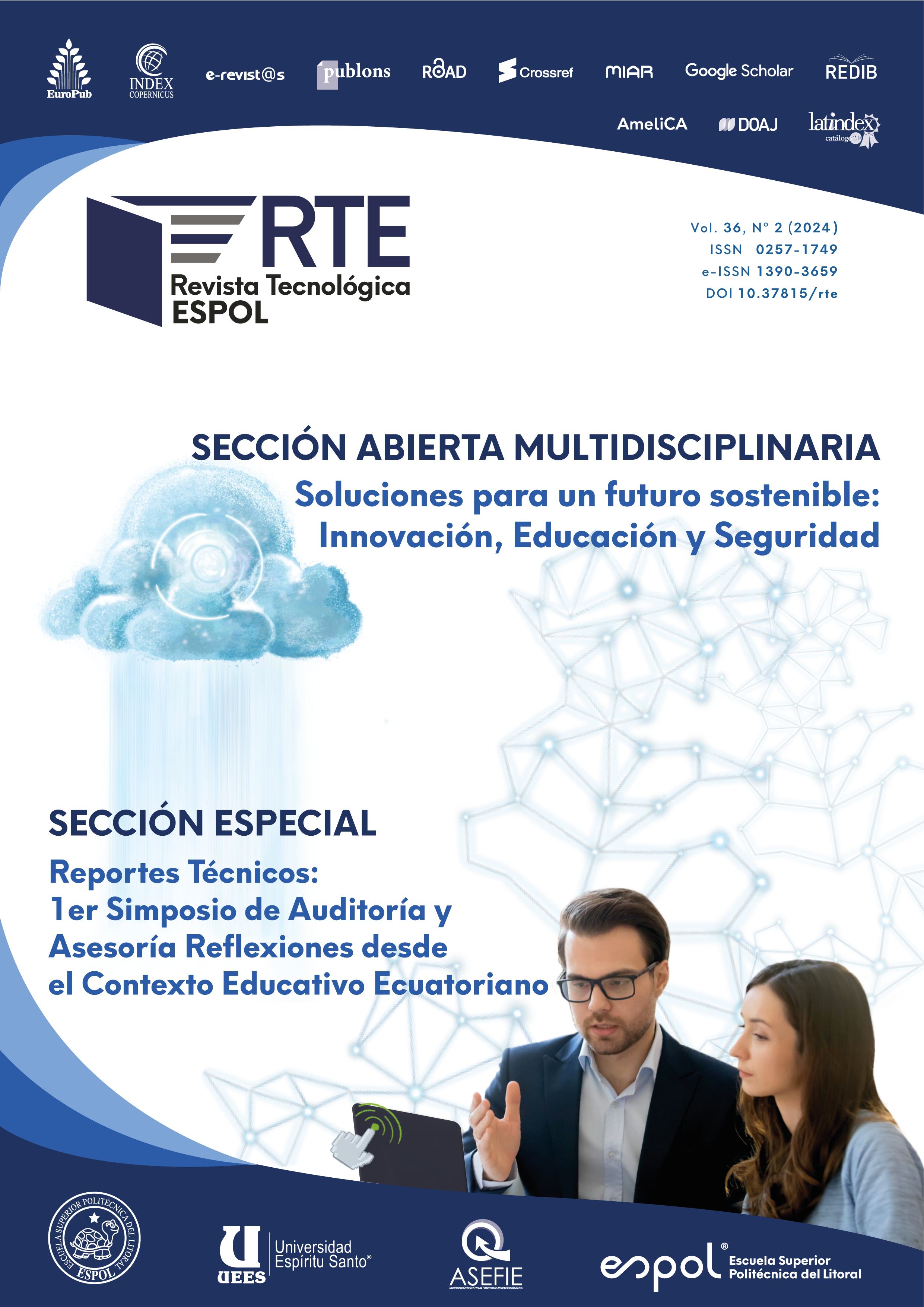Este artículo muestra un diagnóstico de la aplicación de los certificados digitales en los servicios de banca virtual del Ecuador. La importancia de esta temática se fundamenta en los crecientes ataques a los servicios electrónicos de plataformas financieras en la región y el mundo, a causa de la explotación de vulnerabilidades descubiertas por ciberdelincuentes, en la frágil aplicación de los conjunto de cifrados. El objetivo de la investigación es mostrar el nivel de seguridad que poseen estos portales de banca online (personas), en la aplicabilidad de los protocolos SSL/TLS, con sus respectivos suites de cifrados del lado del servidor. Para ello, se analizaron 18 entidades financieras, mediante la herramienta en línea SSL server Test de Qualys SSLLabs. Se encontró que el 20% de las entidades bancarias analizadas presentan debilidad en la aplicabilidad de los certificados digitales, lo que podría ocasionar ataques informáticos a dichas plataformas virtuales, durante el proceso de comunicación entre cliente/servidor a través del servicio de internet. La confidencialidad, integridad y disponibilidad de los datos son características indispensables de la seguridad de la información que un usuario debe recibir en el servicio de banca virtual personas. Como aporte adicional de este trabajo, se realiza una revisión de las recomendaciones de uso de certificados digitales de acuerdo con las regulaciones que emite la IETF a través de los respectivos RFC.

Esta obra está bajo una licencia internacional Creative Commons Atribución-NoComercial 4.0.
Referencias
Advisory, S. (2014). This POODLE Bites : Exploiting The. Google Security Blog. https://security.googleblog.com/2014/10/this-poodle-bites-exploiting-ssl-30.html
Aviram, N., Schinzel, S., Somorovsky, J., Heninger, N., Dankel, M., Steube, J., Valenta, L., Adrian, D., Halderman, J. A., Dukhovni, V., Käsper, E., Cohney, S., Engels, S., Paar, C., & Shavitt, Y. (2016). Drown: Breaking TLS using SSLv2. Proceedings of the 25th USENIX Security Symposium, 689–706. https://drownattack.com/drown-attack-paper.pdf
Bleichenbacher, D. (1998). A Chosen Ciphertext Attack against Protocols based on the RSA Encryption Standard PKCS textsfsymbol351. Proc. of Crypto ’98, 1462, 1–12.
Blog de Internet Security Auditors: Seguridad SSL/TLS: LUCKY 13. (n.d.). Retrieved January 7, 2024, from https://blog.isecauditors.com/2020/04/seguridad-ssl-tls-lucky13.html
Böck, H., Somorovsky, J., & Young, C. (2017). Return Of Bleichenbacher’s Oracle Threat (ROBOT). Cryptology EPrint Archive.
Centro Criptográfico Nacional. (2023). Guía de Seguridad de las TIC CCN-STIC 221 Guía de Mecanismos Criptográficos autorizados por el CCN. https://www.ccn-cert.cni.es/es/guias-de-acceso-publico-ccn-stic/6954-ccn-stic-221-guia-de-mecanismos-criptograficos-autorizados-por-el-ccn-1/file.html
Centro Criptológico Nacional. (2017). Guía de Seguridad de las TIC CCN-STIC 811. Interconexión en el ENS. https://www.ccn-cert.cni.es/es/series-ccn-stic/800-guia-esquema-nacional-de-seguridad/521-ccn-stic-811-interconexion-en-el-ens/file?format=html
Cisco. (2017). SSL Introduction with Sample Transaction and Packet Exchange - Cisco. 1–8. https://www.cisco.com/c/en/us/support/docs/security-vpn/secure-socket-layer-ssl/116181-technote-product-00.html#anc6
CVE - MITRE. (2014). CVE Record | CVE. CVE - MITRE. https://cve.mitre.org/cgi-bin/cvename.cgi?name=CVE-2019-6593
Dell, K. M., & Farrell, E. S. (2021). RFC 8996 Deprecating TLS 1.0 and TLS 1.1. Internet Engineering Task Force, 3329, 8422. https://www.rfc-editor.org/info/rfc8996
Dierks, T., & Allen, C. (1999). The TLS Protocol Version 1.0 (Issue 2246). https://www.ietf.org/rfc/rfc2246.txt
Dierks T. and Rescorla E. (n.d.). The Transport Layer Security (TLS) Protocol Version 1.2 [RFC 5246]. Retrieved May 10, 2022, from https://www.rfc-editor.org/rfc/pdfrfc/rfc5246.txt.pdf
Factoring, F., & Export, R. S. A. (1990). Vulnerabilidad Freak de SSL. https://www.ecucert.gob.ec/wp-content/uploads/2021/07/Ficha-Tecnica-Freak-SSL.pdf
Hodges, J., Jackson, C., & Barth, A. (2012). HTTP Strict Transport Security (HSTS). In IETF - Internet Engineering Task Force. https://doi.org/10.17487/rfc6797
IBM. (2021). Cipher suite considerations when upgrading to TLS V1.2 - IBM Documentation. https://www.ibm.com/docs/en/zos/2.4.0?topic=protocols-cipher-suite-considerations-when-upgrading-tls-v12
Merget, R., Somorovsky, J., Aviram, N., Young, C., Fliegenschmidt, J., Schwenk, J., & Shavitt, Y. (2019). Scalable Scanning and Automatic Classification of TLS Padding Oracle Vulnerabilities. USENIX Security Symposium.
OpenSSL. (2016). Memory corruption in the ASN.1 encoder (CVE-2016-2108). https://www.openssl.org/news/secadv/20160503.txt
Qualys, I. (2015). SSL Server Test. Projects. https://www.ssllabs.com/ssltest/
Rescorla, E. (2008). [ECC] TLS Elliptic Curve Cipher Suites with SHA-256/384 and AES Galois Counter Mode (GCM) [RFC 5289]. RFC 5289, 1–6. https://datatracker.ietf.org/doc/html/rfc5289
Rescorla, E. (2018). The Transport Layer Security (TLS) Protocol Version 1.3 [RFC 8446]. https://doi.org/https://doi.org/10.17487/rfc8446
Ristic, I. (2017). SSL and TLS Deployment Best Practices. Wiki, 4(December), 1–14. https://github.com/ssllabs/research/wiki/SSL-and-TLS-Deployment-Best-Practices
Ristić, I. (2014). Bulletproof SSL and TLS: Understanding and Deploying SSL/TLS and PKI to Secure Servers and Web Applications (Feisty Duck Limited (Ed.); Vol. 2015, Issue build 592). https://www.feistyduck.com/books/bulletproof-tls-and-pki/bulletproof-tls-and-pki-2ed-sample.pdf
Rizzo, J., & Duong, T. (2011). The Beauty (RC4) and The BEAST (TLS) – HACKMAGEDDON. Hakmagenon. https://www.hackmageddon.com/2011/09/25/the-beauty-rc4-and-the-beast-tls/
Sannegowda, Y. (2019). Zombie POODLE and GOLDENDOODLE Vulnerabilities | Qualys Security Blog. https://blog.qualys.com/product-tech/2019/04/22/zombie-poodle-and-goldendoodle-vulnerabilities
Sheffer, Y., Saint-Andre, P., & Fossati, T. (2022, November). Recommendations for Secure Use of Transport Layer Security (TLS) and Datagram Transport Layer Security (DTLS). https://doi.org/10.17487/RFC9325
SSL Pulse. (2019). Qualys SSL Labs - SSL Pulse. SSL Pulse. https://www.ssllabs.com/ssl-pulse/
Statcounter. (2023). Desktop Windows Version Market Share Ecuador | Statcounter Global Stats. In Statcounter Global Stats. https://gs.statcounter.com/windows-version-market-share/desktop/ecuador/#monthly-202209-202309-bar
SUPERINTENDENCIA DE BANCOS. (2023). Calificación de Riesgo Instituciones Financieras. Web Page. https://www.superbancos.gob.ec/bancos/calificacion-de-riesgo-instituciones-financieras-2022/
The Internet Engineering Task Force (IETF). (n.d.). Introduction to the IETF. Retrieved January 5, 2024, from https://www.ietf.org/about/introduction/
The Internet Engineering Task Force (IETF). (2004). RFC 3749 - TLS Compression Methods. https://www.rfc-editor.org/rfc/pdfrfc/rfc3749.txt.pdf
Vaudenay, S. (2002). Security flaws induced by cbc padding – Applications to SSL, IPSEC, WTLS. Lecture Notes in Computer Science (Including Subseries Lecture Notes in Artificial Intelligence and Lecture Notes in Bioinformatics), 2332, 534–545. https://doi.org/https://doi.org/10.1007/3-540-46035-7_35
Young, C. (2019a). Introducing Zombie POODLE and GOLDENDOODLE. Tripwire. https://www.tripwire.com/state-of-security/zombie-poodle-goldendoodle
Young, C. (2019b). “TripWire Vert, What is GOLDENDOODLE Attack?” https://www.tripwire.com/state-of-security/goldendoodle-attack







